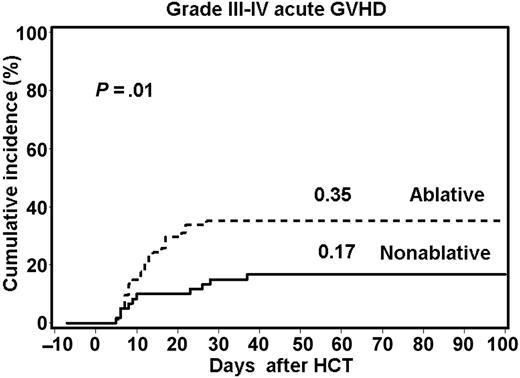We greatly appreciate Dr Brian Abbott's commentary1 on the publication by Diaconescu et al,2 which compared toxicities and non-relapse mortality in patients undergoing HLA-matched related hematopoietic cell transplantation (HCT) following either nonablative or ablative conditioning, and we would like to make 3 points in response to his cautionary notes. First, we recently published very similar observations in patients given unrelated HCT.3 All nonablative patients in that study received 2 Gy total body irradiation preceded by 3 doses of fludarabine, 30 mg/m2/d for 3 days. Even though nonablative patients had significantly higher pretransplantation comorbidity scores, were older, and had more often failed preceding ablative HCT and cytotoxic chemotherapies, they experienced fewer grades III-IV toxicities than ablative patients. The 1-year nonrelapse mortality was 20% in nonablative compared with 32% in ablative patients, a difference that was significant after adjusting for pretransplantation differences between the 2 groups of patients (P = .04).
Second, while we agree that no long-term follow-up data on disease control are available as yet, early results in patients with multiple myeloma, non-Hodgkin lymphoma, chronic lymphocytic leukemia, and acute myelocytic leukemia look encouraging.4-7
Third, the graft-versus-host disease (GVHD) incidence among nonablative recipients was lower than that among their ablative counterparts,3,8 and this was most pronounced for grades III-IV acute GVHD among unrelated recipients (Figure 1).
Grades III-IV acute GVHD in concurrent groups of nonablative and ablative patients given unrelated HCT (P = .01). Solid line indicates nonablative patients; broken line, ablative patients.
Grades III-IV acute GVHD in concurrent groups of nonablative and ablative patients given unrelated HCT (P = .01). Solid line indicates nonablative patients; broken line, ablative patients.
Finally, we share Dr Abbott's enthusiasm for the use of the Charlson Comorbidity Index (CCI) to evaluate patients before HCT. Patients with CCI scores of 1 or higher might benefit from undergoing nonablative HCT, regardless of their age.


This feature is available to Subscribers Only
Sign In or Create an Account Close Modal